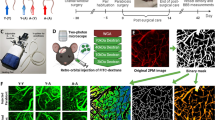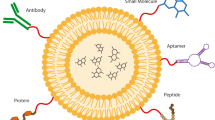Abstract
Transforming growth factor-β (TGF-β) from the periphery can cross the disrupted blood-brain barrier (BBB) to exert neuroprotective effects on the brain. Here, we quantify its permeation across the normal mouse BBB. By high-performance liquid chromatography, we show that TGF-β1 is stable in circulating blood but does not cross the intact BBB after intravenous injection any faster than the vascular marker 99mTc-albumin. This poor rate of influx cannot be explained by rapid efflux out of the brain or lack of lipophilicity as measured by the octanol/buffer partition coefficient, although the hydrogen bonding potential was relatively high, consistent with poor penetration. Thus, the therapeutic potential of TGF-β1 administered in blood is probably limited to situations in which the BBB has been disrupted.
Similar content being viewed by others
References
Banks W. A., Fasold M. B., and Kastin A. J. (1997) Measurement of efflux rates from brain to blood, in Neuropeptide Protocols. Methods Mol. Biol. 73, 353–360.
Chikhale E. G., Burton P. S., and Borchardt R. T. (1995) The effect of verapamil on the transport of peptides across the blood-brain barrier in rats: kinetic evidence for an apically polarized efflux mechanism. J. Pharmacol. Exp. Ther. 273, 298–303.
Kastin A. J. and Akerstrom V. (1999a) Entry of CART into brain is rapid but not inhibited by excess CART or leptin. Am. J. Physiol. 277, E901-E904.
Kastin A. J. and Akerstrom V. (1999b) Nonsaturable entry of neuropeptide Y into the brain. Am. J. Physiol. 276, E479-E482.
Kastin A. J. and Akerstrom V. (2000) Mahogany (1377–1428) enters brain by a saturable transport system. J. Pharmacol. Exp. Ther. 294, 633–636.
Kastin A. J., Akerstrom V., and Hackler L. (2000a) Agouti-related protein (83–132) aggregates and crosses the blood-brain barrier slowly. Metabolism 49, 1444–1448.
Kastin A. J., Akerstrom V., and Hackler L. (2001a) Food deprivation decreases blood galanin-like peptide and its rapid entry into the brain. Neuroendocrinology 74, 423–432.
Kastin A. J., Akerstrom V., Hackler L., and Pan W. (2001b) Adrenomedullin and the blood-brain barrier. Horm. Metab. Res. 33, 19–25.
Kastin A. J., Akerstrom V., Hackler L., and Zadina J. E. (2000b) Phe13,Tyr19-melanin-concentrating hormone and the blood-brain barrier: role of protein binding. J. Neurochem. 74, 385–391.
Kastin A. J., Akerstrom V., and Pan W. (2001c) Validity of multiple-time regression analysis in measurement of tritiated and iodinated leptin crossing the blood-brain barrier: meaningful controls. Peptides 22, 2127–2136.
Kastin A. J., Akerstrom V., and Pan W. (2002) Interactions of glucagon-like peptide-1 (GLP-1) with the blood-brain barrier. J. Molec. Neurosci. 18, 7–14.
Lagord C., Berry M., and Logan A. (2002) Expression of TGFβ2 but not TGFβ1 correlates with the deposition of scar tissue in the lesioned spinal cord. Mol. Cell. Neurosci. 20, 69–92.
Morganti-Kossman M. C., Hans V. H., Lenzlinger P. M., Dubs R., Ludwig E., Trentz O., and Kossmann T. (1999) TGF-beta is elevated in the CSF of patients with severe traumatic brain injuries and parallels blood-brain barrier function. J. Neurotrauma 16, 617–628.
Pan W., Banks W. A., Fasold M. B., Bluth J., and Kastin A. J. (1998) Transport of brain-derived neurotrophic factor across the blood-brain barrier. Neuropharmacology 37, 1552–1561.
Pan W. and Kastin A. J. (1999) Penetration of neurotrophins and cytokines across the blood-brain/blood-spinal cord barrier. Adv. Drug Delivery Rev. 36, 291–298.
Sometani A., Kataoka H., Nitta A., Fukumitsu H., Nomoto H., and Furukawa S. (2001) Transforming growth factor-beta1 enhances expression of brain-derived neurotrophic factor and its receptor, TrkB, in neurons cultured from rat cerebral cortex. J. Neurosci. Res. 66, 369–376.
Vawter M. P., Dillon-Carter O., Tourtellotte W. W., Carvery P., and Freed W. J. (1996) TGFbeta1 and TGFbeta2 concentrations are elevated in Parkinson’s disease in ventricular cerebrospinal fluid. Exp. Neurol. 142, 313–322.
Author information
Authors and Affiliations
Corresponding author
Rights and permissions
About this article
Cite this article
Kastin, A.J., Akerstrom, V. & Pan, W. Circulating TGF-β1 does not cross the intact blood-brain barrier. J Mol Neurosci 21, 43–48 (2003). https://doi.org/10.1385/JMN:21:1:43
Received:
Accepted:
Issue Date:
DOI: https://doi.org/10.1385/JMN:21:1:43




